Assessing Ecosystem and Urban Services for Landscape Suitability Mapping
Abstract
:1. Introduction
- Agricultural activities, which need materials (seeds, fertilizers, instruments, tractors, etc.), and regulation services that allow them to reduce economic and environmental costs of production, such as pest regulation, pollination, erosion control, and others. In an open economy, they also need infrastructures to transport the inputs and outputs of their activity [26,27,28];
- Transportation and commercial activities, which need transport infrastructures to carry on their economic activity. They also rely on the presence of agriculture, industry, and commerce that provide material to transport [25];
- Industrial activities, which rely on the presence of different material provision and transport networks;
2. Materials and Methods
2.1. Study Area
2.2. Model Development and Application
2.2.1. Definition of the Services’ Classification
2.2.2. Scenarios Definition and Ranking of Services
2.2.3. Services’ Weights Calculation
2.2.4. Services Spatialization
2.2.5. Service Indicators’ Normalization
2.2.6. Weighting and Aggregation of Spatial Indices
2.3. Sensitivity Analysis
2.3.1. Understand the Model’s Behaviour under Changing Service Values
2.3.2. Understand the Model’s Behaviour under Changing Services Ranking
2.3.3. Understand the Model’s Behaviour under Changing Service Weights
3. Results and Discussion
3.1. Landscape Suitability Assessment
3.2. Sensitivity Analysis
3.2.1. Model’s Behaviour under Changing Service Values
3.2.2. Model’s Behaviour under Changing Services Ranking
3.2.3. Model’s Behaviour under Changing Service Weights
4. Conclusions
Supplementary Materials
Author Contributions
Funding
Institutional Review Board Statement
Informed Consent Statement
Data Availability Statement
Acknowledgments
Conflicts of Interest
Appendix A
- Habitat suitability for the most common edible species. It quantifies the provisioning of nutrition goods “wild plants, algae and their outputs” (112wildpl) as suggested by [64]. The indicator was calculated as follows:
- ○
- Data collection: Data from Global Biodiversity Information Facility (GBIF) database were collected for each edible plant and fungi species localized in the study area. Information about edible species was retrieved from actaplantarum.org (accessed on 15 April 2020). A geobotanic map was used as a database of the land use of the area;
- ○
- Calculation: The potential habitats of each different species were listed and, then, identified on the geobotanic map. The elevation at which each species typically live was also considered to define each species’ potential habitat better. Then, a buffer of 5 km around the potential service benefiting area was built [55] to select the landscape areas where the service can benefit the residents. The potential habitat areas of each edible species were selected between the many land uses included in the buffer. The service indicator was calculated as the sum of the species potentially present in each point of the study area. As nine edible species were assessed, the indicator value varies between 0 and 9.
- Building density: It is used as an indicator for provisioning of nutrition goods, namely groundwater and surface water availability for drinking purposes (115grdrin, 116 surdrin) and energy from fossil fuels (134netener). This indicator can be considered a meaningful proxy of the quantity of these services, as, in Italy, they are associated by law with the construction of new buildings. The radius used for the Kernel Density Estimation is 200 m, which is the distance from the electricity cabin at which a typical local electricity service asks for a supplementary payment. It is calculated as follows:
- ○
- Data collection: a municipal database was used to extract buildings, their covered areas, and their number of floors;
- ○
- Calculation: Kernel density estimation (KDE) of the total floor area of buildings, obtained by multiplying the number of floors of a building by the building dimension.
- Easiness of wells digging: It is used as an indicator of the service: provisioning of groundwater for the non-drinking purpose (intended as material for different production uses) (122grnodrin). The indicator was calculated as follows:
- ○
- Data collection: A database from local public authorities reporting the wells registered across the territory was collected. This database also includes the wells’ depth;
- ○
- Calculation: inverse distance weighting was applied to the difference between the maximum depth of a well (conventionally defined as 50 m) and the actual well depth.
- Average water yield from rivers and water reservoirs was calculated to quantify the provisioning of surface water for non-drinking purposes (123surnodrin). The service was spatialized based on the following empirical observations: (1) a total amount of 2% of the average river flow can be used for industrial and agricultural uses; (2) about 40% of the total volume of reservoirs is available yearly. The indicator was calculated as follows:
- ○
- Data collection: a database of the water reservoirs, indicating the water volume capacity, and a database of the rivers and streams, indicating the average flow rate, were collected from local public authorities;
- ○
- Calculation: River flow rates and water reservoir volumes were multiplied by the percentages of availability observed empirically, resulting in the calculation of the average daily water availability. This value was distributed on a 50 m buffer area around each watercourse or reservoir.
- Coppices: It has been used to estimate the provision of plant-based resources for energy (131planres). The indicator was calculated as follows:
- ○
- Data collection: The forest map of Umbria was used as a dataset for the estimation of this indicator. It categorizes the forests with many attributes, such as accessibility of each forested land, which were assessed in the forest map, mainly based on slope;
- ○
- Calculation: the intensity of the service delivery was based on the levels of forest accessibility defined by the map: 1 = not sufficient, 2 = low, 3 = good.
- Energy plants powered by livestock manure. It was used to map the provision of animal-based resources for energy (132animres). The indicator was calculated as follows:
- ○
- Data collection: a municipal database of energy plants powered by livestock manure, including each plant’s maximum power, was used;
- ○
- Calculation: Biomass plants powered by manure were spatialized based on coordinates reported in the municipal databases and integrated with local knowledge. Then, the maximum power produced by each plant was used to define service intensity. The service was spatialized by a KDE application (radius = 50 m), since the energy produced can be transported from the plant at increasing costs with increasing distances.
- Cumulated avoided runoff due to land cover. It expresses the buffering and attenuation of mass flows in river basins and flood protection by natural subsystems (211ecoflood). This service, delivered downstream by the water retention property of soils, is a regulating service of natural physical phenomena:
- ○
- Data collection: A database of the rivers and streams from the local authorities was used to localize water streams. The geobotanic map was used for the LULC definition, while the EU-DEM [65] was used to define topographic variables, such as slope;
- ○
- Calculation: The soil conservation service curve number (SCS-CN) equation was used for calculating runoff [66,67] both in the actual situation and in a theoretical worst case, where all the study area is covered by built surface. The areas covered by rivers and water streams were excluded from the results. Based on [68], soil moisture was set as 20% of the potential maximum soil retention (S) in both cases, and the rain event considered was the highest one-day precipitation amount of the last ten years (100 mm) [69]. The cumulated upstream runoff reduction was calculated as the cumulated difference between the worst-case runoff and the actual runoff in each cell.
- Percentage of avoided runoff by artificial reservoirs at sub-basin scale. It expresses the buffering and attenuation of mass flows in river basins and flood protection by human subsystems, a regulating service of natural physical phenomena (212urflood). The service was calculated as follows:
- ○
- Data collection: a climate database of rain was used to analyse precipitation amounts, while sub-basins were defined based on EU-DEM dataset;
- ○
- Calculation: Total water runoff per each sub-basin was calculated by SCS-CN equation [66,67], setting the soil moisture as 20% of the potential maximum soil retention (S) [68], while the rain event considered in the model is the highest one-day precipitation amount of the last ten years (100 mm) [69]. Then, the total volume of reservoirs in each sub-basin was calculated. At the sub-basin level, the indicator intensity was calculated as 30% of the ratio between the total volume of the reservoirs and the total water runoff.
- Amount of avoided erosion by agri-natural surfaces and urban surfaces. These indicators were used, respectively, to spatialize services for the regulation of natural physical phenomena, namely the mass stabilization and control of erosion rates by natural (213ecoeros) and human (214urberos) subsystems:
- ○
- Data collection: geobotanic map and EU-DEM were used as input databases;
- ○
- Calculation: The amount of avoided erosion was calculated as the difference of eroded soil in the actual situation and in a theoretical worse case, where all the surface was supposed covered by bare soil. For this purpose, the revised universal soil loss equation (RUSLE) was applied [70]. While R is considered constant, the K factor (soil erodibility) from [71] was used in agricultural and natural areas. The K factor in urban areas was roughly estimated using focal mean, with radius = 500 m. The length and slope (LS) factor was retrieved from [72], while C was calculated associating the RUSLE C factor tables to land covers indicated in the geobotanic map. Since the anti-erosion effect is delivered locally, the avoided erosion was clipped into urban areas for estimating service 214, while it was clipped into the other lands’ uses for estimating the quantity of the service 213 delivered.
- Average pest predation rate. It quantifies the pest and disease control by natural subsystem, which is a regulating service for maintaining physical, chemical, and biological conditions (231ecopestcont). For the indicator calculation, we adapted the methodology suggested by [73]:
- ○
- Data collection: The geobotanic map was used for the identification of land use and land covers. A map of the linear features was autonomously designed by photo interpretation;
- ○
- Calculation: Habitats of pest predators were identified on the geobotanic map and the linear features map. Then, the percentage of LULC covered by the predators’ habitat in a radius of 2 km was calculated by focal mean. Then, the predation rate was calculated by the following equation [73]:where A is the average habitat size of a given natural predator.19.65 + (0.309 × A)
- Land quality indicator. It expresses a service within the division of “maintenance of physical, chemical, and biological conditions”, namely the weather decomposition and fixing processes (234pedogen). For the calculation of this indicator, we adapted the methodology suggested by [74]:
- ○
- Data collection: www.isric.org/explore/soilgrids (Accessed on 6 May 2020) database at 250 m resolution was used for mapping fertility factors;
- ○
- Calculation: To calculate the land quality indicator, scores suggested in the paper were attributed to five fertility factors (organic C content, clay + silt, pH, cation exchange capacity, and soil depth). The factors were reclassified as “poor” (1), “medium” (2), “good” (3), and “excellent” (4) and, then, summed, producing an indicator with a minimum value of 5 and a maximum value of 17. Zero was associated with the urban areas.
- Areas contributing to water flows in forested or wooded areas. This indicator was used to spatially quantify the maintenance of chemical conditions of freshwater by natural subsystems (235ecowatqual), which is a regulating service for the maintenance of physical, chemical, and biological conditions:
- ○
- Data collection: geobotanic map and EU-DEM were used as input databases;
- ○
- Calculation: Flow accumulation was calculated for the whole study area to calculate this indicator. Then, only the forested cells—the service provisioning area of this service—were selected.
- Buffer from depurators. It was calculated to map the maintenance of chemical conditions of freshwater by human subsystems (236urwatqual), which is a regulating service for the maintenance of physical, chemical, and biological conditions. The indicators spatialize and quantify the ability of man-made systems to maintain clean water:
- ○
- Data collection: a database of local depurators was collected from public authorities;
- ○
- Calculation: A 500-metre buffer was considered adequate for mapping the SBA, since all the depurators are nearby the rivers. The intensity considered is represented by equivalent inhabitants.
- Recreational potential of the agri-natural areas. It expresses the experiential and physical potential use of plants, animals, and land/seascapes in different environmental settings (313ecouse). It is a service related to the physical and intellectual interaction with the agri-natural environment [75]. The indicator was developed considering a previous research [76]:
- ○
- Data collection: geobotanic map was used as an input of the indicator;
- ○
- Calculation: Different scores of recreation potential ranging from 0 to 9 were attributed to the different land-uses in the study area to calculate this indicator. Then, the effect on surrounding areas was summed or subtracted from the base score. In detail: the baseline indicator was used when the cells were surrounded by arable land. When water, forests, or urban areas were within 1 km from a cell, their positive influence was considered. A KDE (radius = 1000 m) was applied to the streams and coasts and then scaled between 0 and 1 to calculate this influence. Then, the watershed effect was added to the baseline indicator. The effect of urban areas was added in the same way, while the effect of forests and woods was added by KDE addition, scaling the results between 0 and 2.
References
- MA (Millennium Ecosystem Assessment). Ecosystems and Human Well-Being: A Framework for Assessment; Island Press: Washington, DC, USA, 2003; ISBN 1559634022. [Google Scholar]
- Duraiappah, A.K. Ecosystem Services and Human Well-being: Do Global Findings Make Any Sense? Bioscience 2011, 61, 7–8. [Google Scholar] [CrossRef]
- Burkhard, B.; Kroll, F.; Nedkov, S.; Müller, F. Mapping ecosystem service supply, demand and budgets. Ecol. Indic. 2012, 21, 17–29. [Google Scholar] [CrossRef]
- Vizzari, M.; Antognelli, S.; Hilal, M.; Sigura, M.; Joly, D. Ecosystem Services Along the Urban--Rural--Natural Gradient: An Approach for a Wide Area Assessment and Mapping. In Computational Science and Its Applications—ICCSA 2015, Proceedings of the 15th International Conference, Banff, AB, Canada, 22–25 June 2015, Part III; Gervasi, O., Murgante, B., Misra, S., Gavrilova, L.M., Rocha, C.A.M.A., Torre, C., Taniar, D., Apduhan, O.B., Eds.; Springer International Publishing: Cham, Switzerland, 2015; pp. 745–757. ISBN 978-3-319-21470-2. [Google Scholar]
- Vizzari, M.; Sigura, M.; Antognelli, S. Ecosystem Services Demand, Supply and Budget Along the Urban-Rural-Natural Gradient. Aktual. Zadaci Meh. Poljopr. 2015, 43, 473–484. [Google Scholar]
- Wu, J. Landscape sustainability science: Ecosystem services and human well-being in changing landscapes. Landsc. Ecol. 2013, 28, 999–1023. [Google Scholar] [CrossRef]
- Saarikoski, H.; Jax, K.; Harrison, P.A.; Primmer, E.; Barton, D.N.; Mononen, L.; Vihervaara, P.; Furman, E. Exploring operational ecosystem service definitions: The case of boreal forests. Ecosyst. Serv. 2015, 14, 144–157. [Google Scholar] [CrossRef]
- Haines-young, R.; Potschin, M. Common International Classification of Ecosystem Services (CICES): Consultation on Version 4, August–December 2012; Centre for Environmental Management, University of Nottingham: Nottingham, UK, 2013. [Google Scholar]
- Nahlik, A.M.; Kentula, M.E.; Fennessy, M.S.; Landers, D.H. Where is the consensus? A proposed foundation for moving ecosystem service concepts into practice. Ecol. Econ. 2012, 77, 27–35. [Google Scholar] [CrossRef]
- Syrbe, R.-U.; Walz, U. Spatial indicators for the assessment of ecosystem services: Providing, benefiting and connecting areas and landscape metrics. Ecol. Indic. 2012, 21, 80–88. [Google Scholar] [CrossRef]
- Bagstad, K.J.; Johnson, G.W.; Voigt, B.; Villa, F. Spatial dynamics of ecosystem service flows: A comprehensive approach to quantifying actual services. Ecosyst. Serv. 2013, 4, 117–125. [Google Scholar] [CrossRef]
- Antognelli, S.; Vizzari, M.; Schulp, C.J.E. Integrating Ecosystem and Urban Services in Policy-Making at the Local Scale: The SOFA Framework. Sustainability 2018, 10, 1017. [Google Scholar] [CrossRef] [Green Version]
- Antognelli, S.; Vizzari, M. Landscape liveability spatial assessment integrating ecosystem and urban services with their perceived importance by stakeholders. Ecol. Indic. 2017, 72, 703–725. [Google Scholar] [CrossRef]
- Malczewski, J. GIS-based multicriteria decision analysis: A survey of the literature. Int. J. Geogr. Inf. Sci. 2006, 20, 703–726. [Google Scholar] [CrossRef]
- Malczewski, J.; Rinner, C. Multicriteria Decision Analysis in Geographic Information Science; Springer: Berlin/Heidelberg, Germany, 2015; ISBN 9783540747567. [Google Scholar]
- Hanssen, F.; May, R.; Van Dijk, J.; Stokke, B.G.; De Stefano, M. Spatial Multi-Criteria Decision Analysis (SMCDA) Toolbox for Consensus-Based Siting of Powerlines and Wind-Power Plants (ConSite). NINA Rapp.; Norwegian Institute for Nature Research: Tromso, Norway, 2018.
- Cervelli, E.; Scotto di Perta, E.; Pindozzi, S. Energy crops in marginal areas: Scenario-based assessment through ecosystem services, as support to sustainable development. Ecol. Indic. 2020, 113, 106180. [Google Scholar] [CrossRef]
- Cervelli, E.; Pindozzi, S.; Capolupo, A.; Okello, C.; Rigillo, M.; Boccia, L. Ecosystem services and bioremediation of polluted areas. Ecol. Eng. 2016, 87, 139–149. [Google Scholar] [CrossRef]
- Saarikoski, H.; Mustajoki, J.; Hjerppe, T.; Aapala, K. Participatory multi-criteria decision analysis in valuing peatland ecosystem services—Trade-offs related to peat extraction vs. pristine peatlands in Southern Finland. Ecol. Econ. 2019, 162, 17–28. [Google Scholar] [CrossRef]
- Lautenbach, S.; Volk, M.; Gruber, B.; Dormann, C.F.; Strauch, M.; Seppelt, R. Quantifying Ecosystem Service Trade-Offs. In Proceedings of the 2012 International Congress on Environmental Modelling and Software—Managing Resources of a Limited Planet, Sixth Biennial Meeting, Leipzig, Germany, 1 July 2012; p. 8. [Google Scholar]
- Albert, C.; Galler, C.; Hermes, J.; Neuendorf, F.; von Haaren, C.; Lovett, A. Applying ecosystem services indicators in landscape planning and management: The ES-in-Planning framework. Ecol. Indic. 2015, 61, 100–113. [Google Scholar] [CrossRef]
- de Haan, F.J.; Ferguson, B.C.; Adamowicz, R.C.; Johnstone, P.; Brown, R.R.; Wong, T.H.F. The needs of society: A new understanding of transitions, sustainability and liveability. Technol. Forecast. Soc. Chang. 2014, 85, 121–132. [Google Scholar] [CrossRef]
- Menconi, M.E.; Tasso, S.; Santinelli, M.; Grohmann, D. A card game to renew urban parks: Face-to-face and online approach for the inclusive involvement of local community. Eval. Program. Plann. 2020, 79, 101741. [Google Scholar] [CrossRef]
- Antognelli, S.; Vizzari, M. Ecosystem and urban services for landscape liveability: A model for quantification of stakeholders’ perceived importance. Land Use Policy 2016, 50, 277–292. [Google Scholar] [CrossRef]
- Landers, D.H.; Nahlik, A.M. Final Ecosystem Goods and Services Classification System (FEGS-CS); EPA/600/R-13/ORD-004914; U.S. Environmental Protection Agency, Office of Research and Development: Washington, DC, USA, 2012.
- Power, A.G. Ecosystem services and agriculture: Tradeoffs and synergies. Philos. Trans. R. Soc. Lond. B Biol. Sci. 2010, 365, 2959–2971. [Google Scholar] [CrossRef] [PubMed]
- Hein, L.; Van Koppen, K.; de Groot, R.S.; Van Ierland, E.C. Spatial scales, stakeholders and the valuation of ecosystem services. Ecol. Econ. 2006, 57, 209–228. [Google Scholar] [CrossRef]
- Menconi, M.E.; Heland, L.; Grohmann, D. Learning from the gardeners of the oldest community garden in Seattle: Resilience explained through ecosystem services analysis. Urban. For. Urban. Green. 2020, 56, 126878. [Google Scholar] [CrossRef]
- Campanera, J.M.; Nobajas, A.; Higgins, P. Modulating the person–environment relationship through local government intervention in England. Appl. Geogr. 2014, 47, 20–32. [Google Scholar] [CrossRef]
- de Groot, R.S.; Alkemade, R.; Braat, L.; Hein, L.; Willemen, L. Challenges in integrating the concept of ecosystem services and values in landscape planning, management and decision making. Ecol. Complex. 2010, 7, 260–272. [Google Scholar] [CrossRef]
- Le Clec’h, S.; Oszwald, J.; Decaens, T.; Desjardins, T.; Dufour, S.; Grimaldi, M.; Jegou, N.; Lavelle, P. Mapping multiple ecosystem services indicators: Toward an objective-oriented approach. Ecol. Indic. 2016, 69, 508–521. [Google Scholar] [CrossRef]
- Coutinho-Rodrigues, J.; Simão, A. A GIS-based multicriteria spatial decision support system for planning urban infrastructures. Decis. Support. Syst. 2011, 51, 720–726. [Google Scholar] [CrossRef]
- Gulinck, H.; Marcheggiani, E.; Verhoeve, A.; Bomans, K.; Dewaelheyns, V.; Lerouge, F.; Galli, A. The Fourth Regime of Open Space. Sustainability 2018, 10, 2143. [Google Scholar] [CrossRef] [Green Version]
- Neri, M.; Menconi, M.E.; Vizzari, M.; Mennella, V.G.G. A proposal of a new methodology for best location of environmentally sustainable roads infrastructures. Validation along the Fabriano-Muccia road. Inf. Constr. 2010, 62, 101–112. [Google Scholar] [CrossRef]
- Abildtrup, J.; Garcia, S.; Olsen, S.B.; Stenger, A. Spatial preference heterogeneity in forest recreation. Ecol. Econ. 2013, 92, 67–77. [Google Scholar] [CrossRef] [Green Version]
- Apparicio, P.; Séguin, A.-M. Measuring the accessibility of services and facilities for residents of public housing in Montréal. Urban Stud. 2006, 43, 187–211. [Google Scholar] [CrossRef]
- Chen, Y.; Yu, J.; Khan, S. Spatial sensitivity analysis of multi-criteria weights in GIS-based land suitability evaluation. Environ. Model. Softw. 2010, 25, 1582–1591. [Google Scholar] [CrossRef]
- Chen, Y.; Yiu, J.; Khan, S. The spatial framework for weight sensitivity analysis in AHP-based multi-criteria decision making. Environ. Model. Softw. 2013, 48, 129–140. [Google Scholar] [CrossRef]
- Delgado, M.G.; Sendra, J.B. Sensitivity analysis in multicriteria spatial decision-making: A review. Hum. Ecol. Risk Assess. 2004, 10, 1173–1187. [Google Scholar] [CrossRef]
- Ganji, A.; Maier, H.R.; Dandy, G.C. A modified Sobol’ sensitivity analysis method for decision-making in environmental problems. Environ. Model. Softw. 2016, 75, 15–27. [Google Scholar] [CrossRef]
- Saltelli, A.; Tarantola, S.; Campolongo, F.; Ratto, M. Sensitivity Analysis in Practice: A Guide to Assessing Scientific Models; John Wiley & Sons: Chichester, UK, 2004. [Google Scholar]
- Feizizadeh, B.; Blaschke, T. An uncertainty and sensitivity analysis approach for GIS-based multicriteria landslide susceptibility mapping. Int. J. Geogr. Inf. Sci. 2014, 28, 610–638. [Google Scholar] [CrossRef] [PubMed] [Green Version]
- Maletič, D.; Maletič, M.; Lovrenčić, V.; Al-Najjar, B.; Gomišček, B. An Application of Analytic Hierarchy Process (AHP) and Sensitivity Analysis for Maintenance Policy Selection. Organizacija 2014, 47, 177–188. [Google Scholar] [CrossRef] [Green Version]
- Büttner, G. CORINE Land Cover and Land Cover Change Products. In Land Use & Land Cover Mapping in Europe: Current Practice, Trends and Future; Springer: Dordrecht, The Netherlands, 2014; Volume 18, pp. 55–74. ISBN 978-94-007-7968-6. [Google Scholar]
- Vizzari, M.; Antognelli, S. Landscapes Along the Urban-Rural- Natural Gradient: Typologies, similarities, Contiguities. In Proceedings of the Geographic Information Systems Conference and Exhibition “GIS ODYSSEY 2017”, Vattaro (TN), Italy, 4–8 September 2017. [Google Scholar]
- Vizzari, M.; Sigura, M. Landscape sequences along the urban–rural–natural gradient: A novel geospatial approach for identification and analysis. Landsc. Urban. Plan. 2015, 140, 42–55. [Google Scholar] [CrossRef]
- Antognelli, S.; Vizzari, M. Liveability services in transitional landscapes: A spatial-MCDA model for assessment and mapping. In Proceedings of the INPUT2016 9th International Conference on Innovation in Urban and Regional Planning, Torino, Italy, 14–15 September 2016. [Google Scholar]
- Comino, E.; Bottero, M.; Pomarico, S.; Rosso, M. The combined use of Spatial Multicriteria Evaluation and stakeholders analysis for supporting the ecological planning of a river basin. Land Use Policy 2016, 58, 183–195. [Google Scholar] [CrossRef]
- Langemeyer, J.; Gómez-Baggethun, E.; Haase, D.; Scheuer, S.; Elmqvist, T. Bridging the gap between ecosystem service assessments and land-use planning through Multi-Criteria Decision Analysis (MCDA). Environ. Sci. Policy 2016. [Google Scholar] [CrossRef]
- Saaty, T.L. Analytic Hierarchy Process; McGraw-Hill: New York, NY, USA, 1980. [Google Scholar]
- Saaty, T.L. A scaling method for priorities in hierarchical structures. J. Math. Psychol. 1977, 15, 234–281. [Google Scholar] [CrossRef]
- Vizzari, M.; Modica, G. Environmental effectiveness of swine sewage management: A multicriteria AHP-based model for a reliable quick assessment. Environ. Manag. 2013, 52, 1023–1039. [Google Scholar] [CrossRef]
- Das, B.; Pal, S.C. Assessment of groundwater vulnerability to over-exploitation using MCDA, AHP, fuzzy logic and novel ensemble models: A case study of Goghat-I and II blocks of West Bengal, India. Environ. Earth Sci. 2020, 79, 104. [Google Scholar] [CrossRef]
- Modica, G.; Merlino, A.; Solano, F.; Mercurio, R. An index for the assessment of degraded Mediterranean forest ecosystems. For. Syst. 2015, 24, e037. [Google Scholar] [CrossRef] [Green Version]
- Kumar, S.; Srivastava, P.K. Snehmani GIS-based MCDA–AHP modelling for avalanche susceptibility mapping of Nubra valley region, Indian Himalaya. Geocarto Int. 2016, 32, 1254–1267. [Google Scholar] [CrossRef]
- Wolff, S.; Schulp, C.J.E.; Verburg, P.H. Mapping ecosystem services demand: A review of current research and future perspectives. Ecol. Indic. 2015, 55, 159–171. [Google Scholar] [CrossRef]
- Swinton, S.M.; Lupi, F.; Robertson, G.P.; Hamilton, S.K. Ecosystem services and agriculture: Cultivating agricultural ecosystems for diverse benefits. Ecol. Econ. 2007, 64, 245–252. [Google Scholar] [CrossRef]
- Tallon, A.R.; Bromley, R.D.F. Exploring the attractions of city centre living: Evidence and policy implications in British cities. Geoforum 2004, 35, 771–787. [Google Scholar] [CrossRef]
- Caschili, S.; De Montis, A.; Trogu, D. Accessibility and rurality indicators for regional development. Comput. Environ. Urban. Syst. 2015, 49, 98–114. [Google Scholar] [CrossRef]
- Tenerelli, P.; Demšar, U.; Luque, S. Crowdsourcing indicators for cultural ecosystem services: A geographically weighted approach for mountain landscapes. Ecol. Indic. 2016, 64, 237–248. [Google Scholar] [CrossRef] [Green Version]
- De Montis, A.; Reggiani, A. Cities special section on “Analysis and Planning of Urban Settlements: The Role of Accessibility”. Cities 2013, 30, 1–3. [Google Scholar] [CrossRef]
- Harker, P.T. Incomplete pairwise comparisons in the analytic hierarchy process. Math. Model. 1987, 9, 837–848. [Google Scholar] [CrossRef] [Green Version]
- Sayadi, S.; Gonzalez, M.G.; Calatrava, J. Ranking versus scale rating in Conjoint Analysis: Evaluating landscapes in mountainous regions in South-Eastern Spain. Ecol. Econ. 2005, 55, 539–550. [Google Scholar] [CrossRef]
- Schulp, C.J.E.; Thuiller, W.; Verburg, P.H. Wild food in Europe: A synthesis of knowledge and data of terrestrial wild food as an ecosystem service. Ecol. Econ. 2014, 105, 292–305. [Google Scholar] [CrossRef]
- CCopernicus Land Monitoring Service—EU-DEM—European Environment Agency. Available online: https://www.eea.europa.eu/data-and-maps/data/copernicus-land-monitoring-service-eu-dem (accessed on 21 July 2021).
- Bo, X.; Qing-Hai, W.; Jun, F.; Feng-Peng, H.; Quan-Hou, D. Application of the SCS-CN Model to Runoff Estimation in a Small Watershed with High Spatial Heterogeneity. Pedosph. An. Int. J. 2011, 21, 738–749. [Google Scholar] [CrossRef]
- Mishra, S.K.; Singh, V.P. SCS-CN Method. In Soil Conservation Service Curve Number (SCS-CN) Methodology; Springer: Dordrecht, The Netherlands, 2003; pp. 84–146. [Google Scholar] [CrossRef]
- Zhan, X.; Huang, M.L. ArcCN-Runoff: An ArcGIS tool for generating curve number and runoff maps. Environ. Model. Softw. 2004, 19, 875–879. [Google Scholar] [CrossRef]
- Haylock, M.R.; Hofstra, N.; Tank, A.M.G.K.; Klok, E.J.; Jones, P.D.; New, M. A European daily high-resolution gridded data set of surface temperature and precipitation for 1950–2006. J. Geophys. Res. Atmos. 2008, 113, D20. [Google Scholar] [CrossRef] [Green Version]
- Fistikoglu, O.; Harmancioglu, N.B. Integration of GIS with USLE in Assessment of Soil Erosion. Water Resour. Manag. 2002, 16, 447–467. [Google Scholar] [CrossRef]
- Panagos, P.; Meusburger, K.; Ballabio, C.; Borrelli, P.; Alewell, C. Soil erodibility in Europe: A high-resolution dataset based on LUCAS. Sci. Total Environ. 2014, 479, 189–200. [Google Scholar] [CrossRef]
- Panagos, P.; Borrelli, P.; Meusburger, K. A New European Slope Length and Steepness Factor (LS-Factor) for Modeling Soil Erosion by Water. Geosciences 2015, 5, 117–126. [Google Scholar] [CrossRef] [Green Version]
- Petz, K.; Schulp, C.J.E.; Van Der Zanden, E.H.; Veerkamp, C.; Schelhaas, M.; Nabuurs, G.; Hengeveld, G. Indicators and Modelling of Land Use, Land Management and Ecosystem Services; PBL Netherlands Environmental Assessment Agency: The Hague, The Netherlands, 2016. [Google Scholar]
- Schiefer, J.; Lair, G.J.; Blum, W.E.H. Indicators for the definition of land quality as a basis for the sustainable intensification of agricultural production. Int. Soil Water Conserv. Res. 2015, 3, 42–49. [Google Scholar] [CrossRef] [Green Version]
- Modica, G.; Zoccali, P.; Di Fazio, S. The e-Participation in Tranquillity Areas Identification as a Key Factor for Sustainable Landscape Planning. In Computational Science and Its Applications—ICCSA 2013 SE 40; Murgante, B., Misra, S., Carlini, M., Torre, C., Nguyen, H.-Q., Taniar, D., Apduhan, B., Gervasi, O., Eds.; Lecture Notes in Computer Science; Springer: Berlin/Heidelberg, Germany, 2013; Volume 7973, pp. 550–565. ISBN 978-3-642-39645-8. [Google Scholar]
- Verhagen, W.; Verburg, P.H.; Schulp, C.J.E.; Sturck, J. Mapping Ecosystem Services. In Ecosystem Services—From Concept to Practice; Bouma, J., van Beukering, P.J.H., Eds.; Cambridge University Press: Cambridge, UK, 2015; pp. 65–86. ISBN 9781107062887. [Google Scholar]
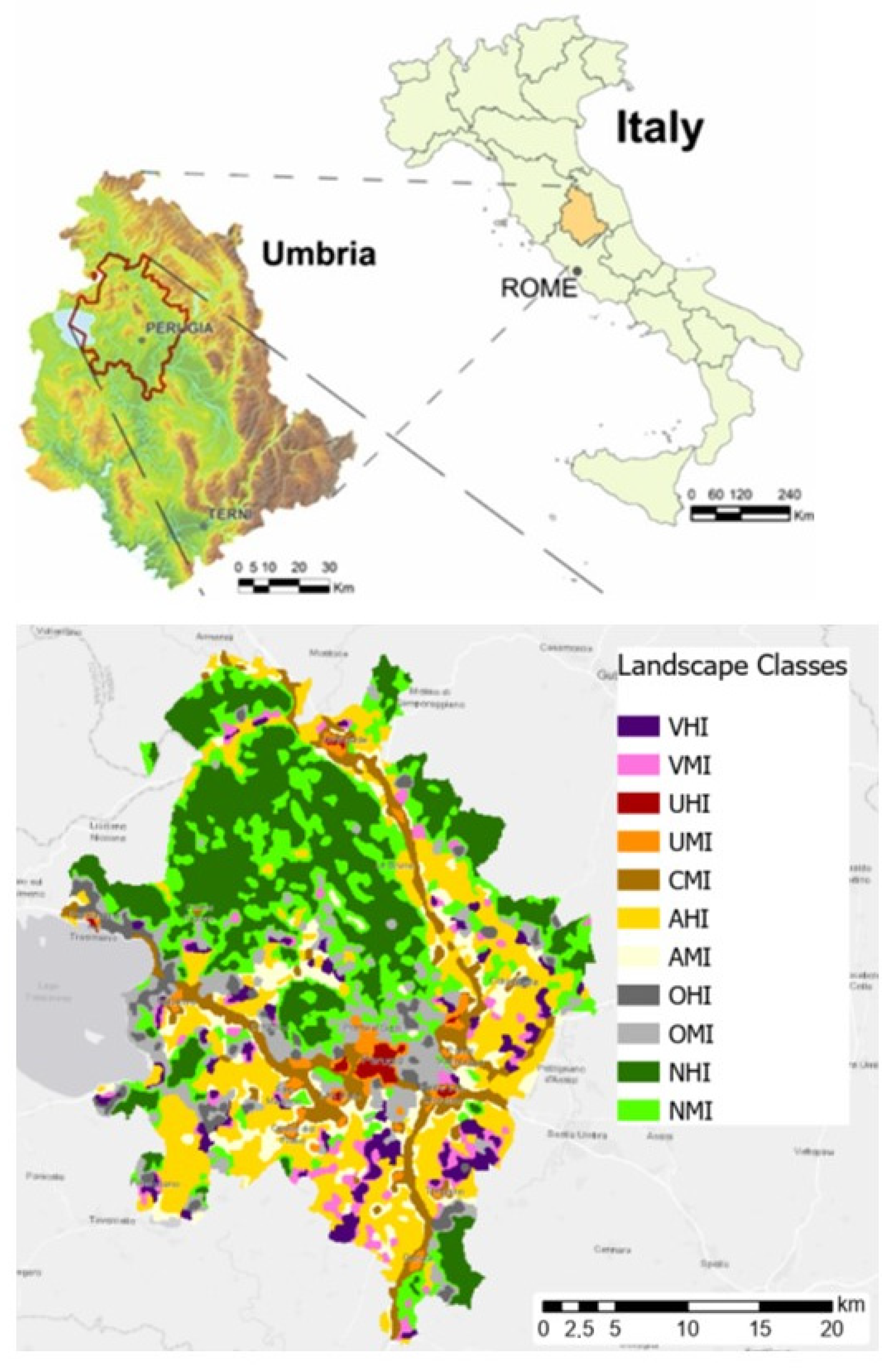
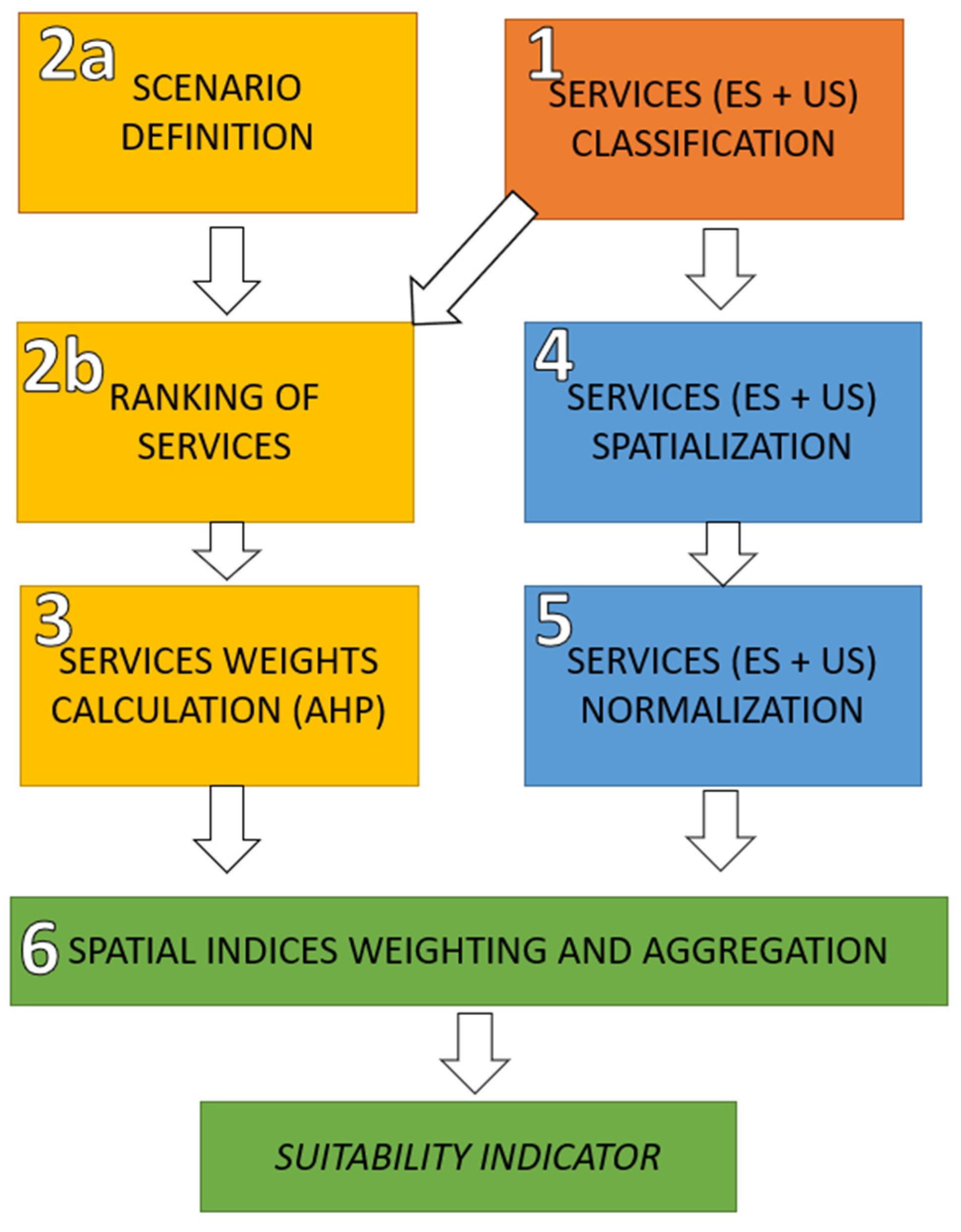
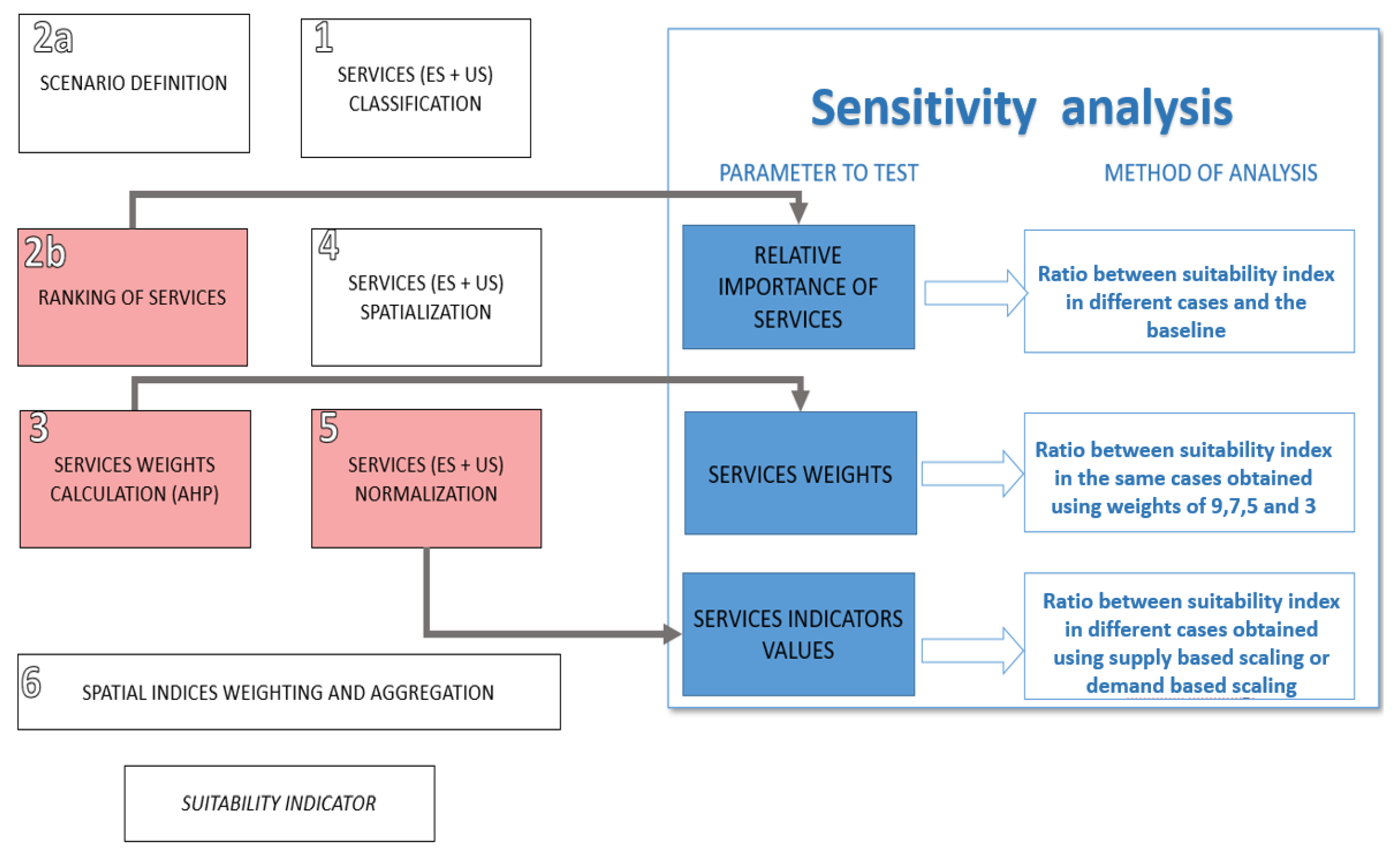
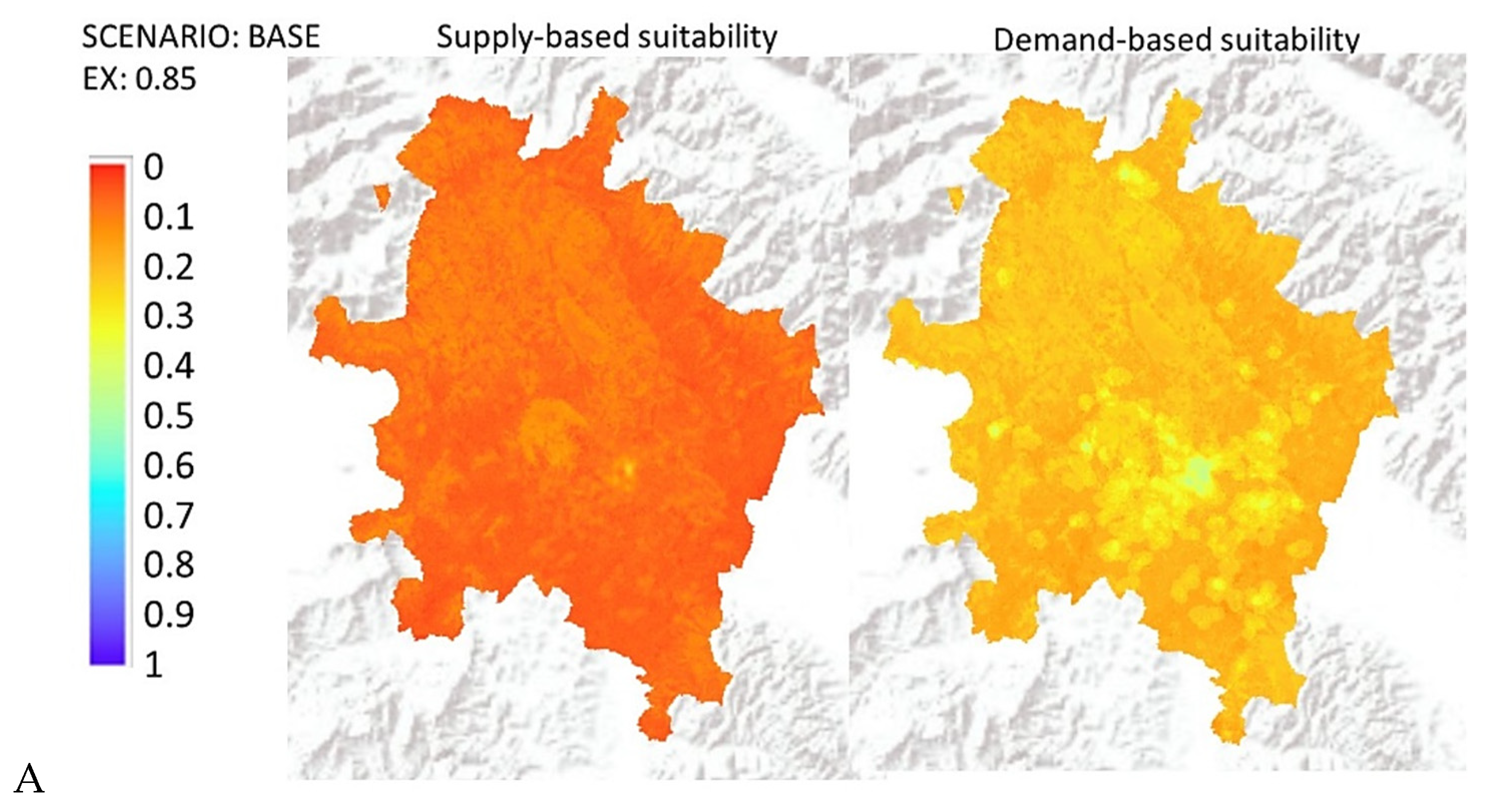
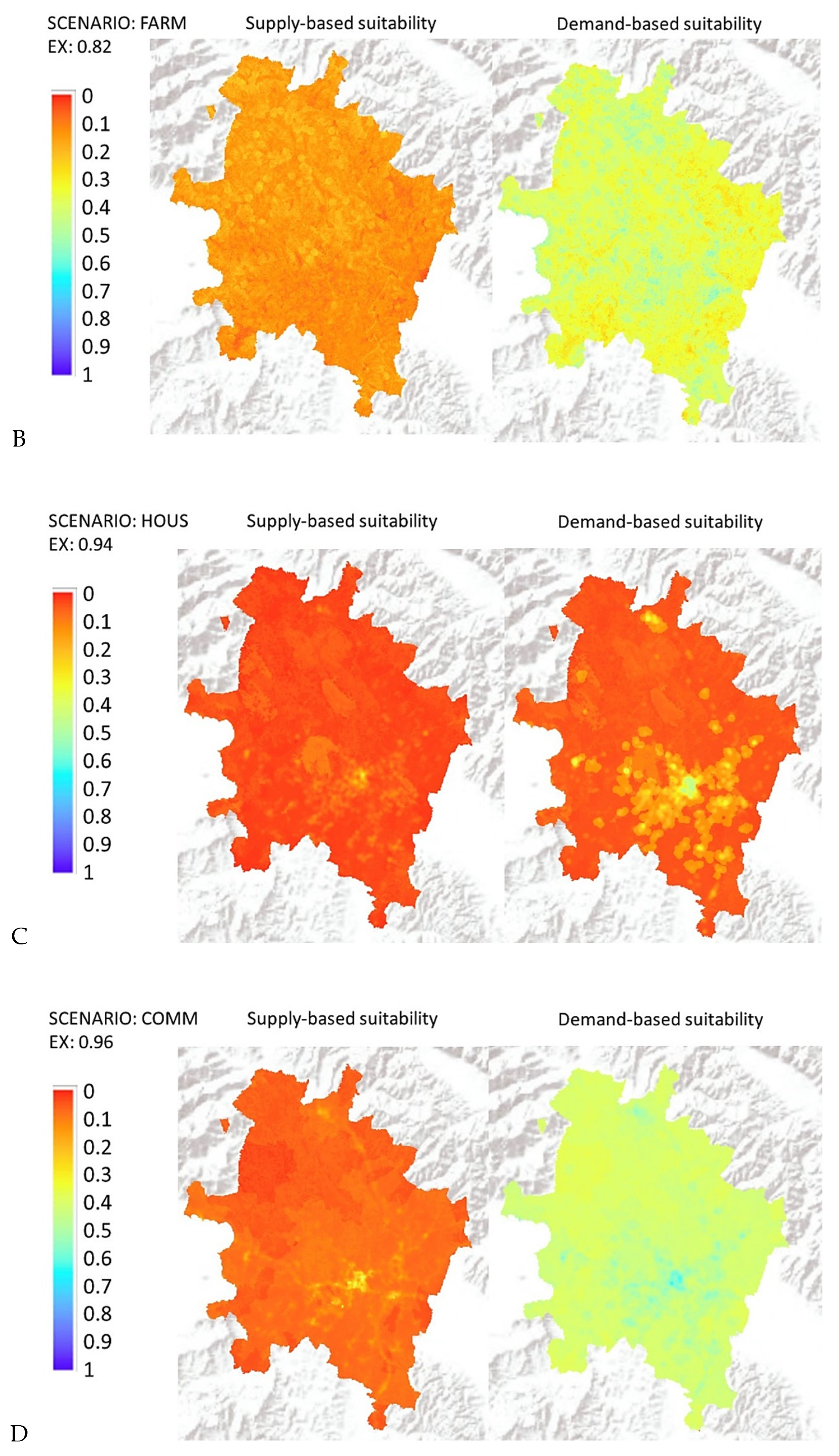
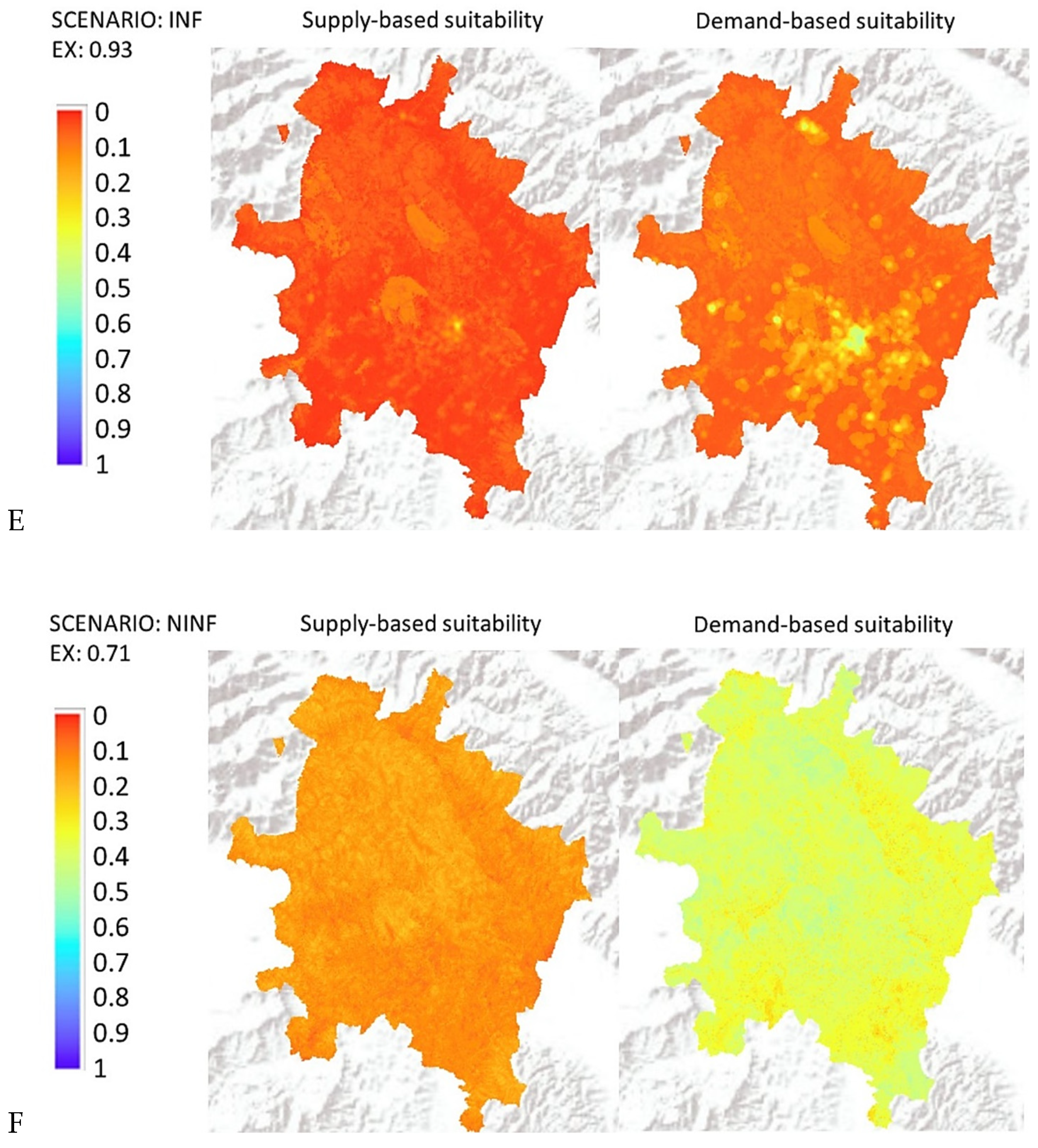

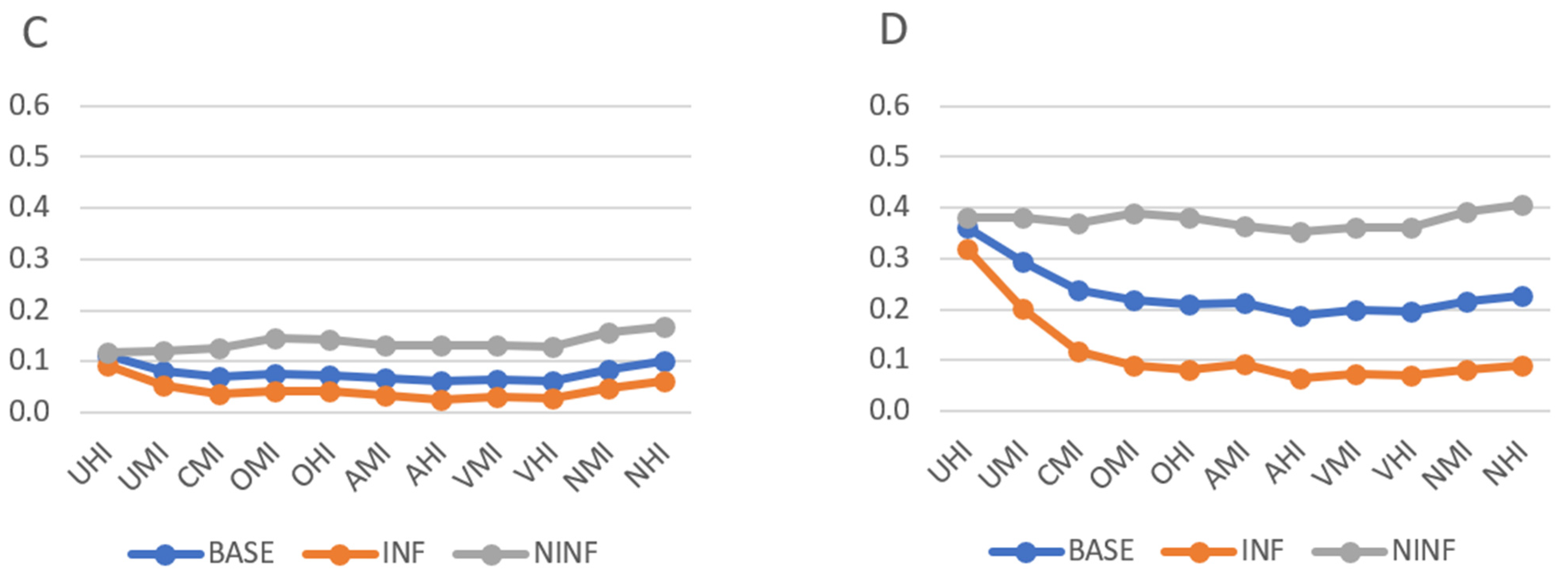

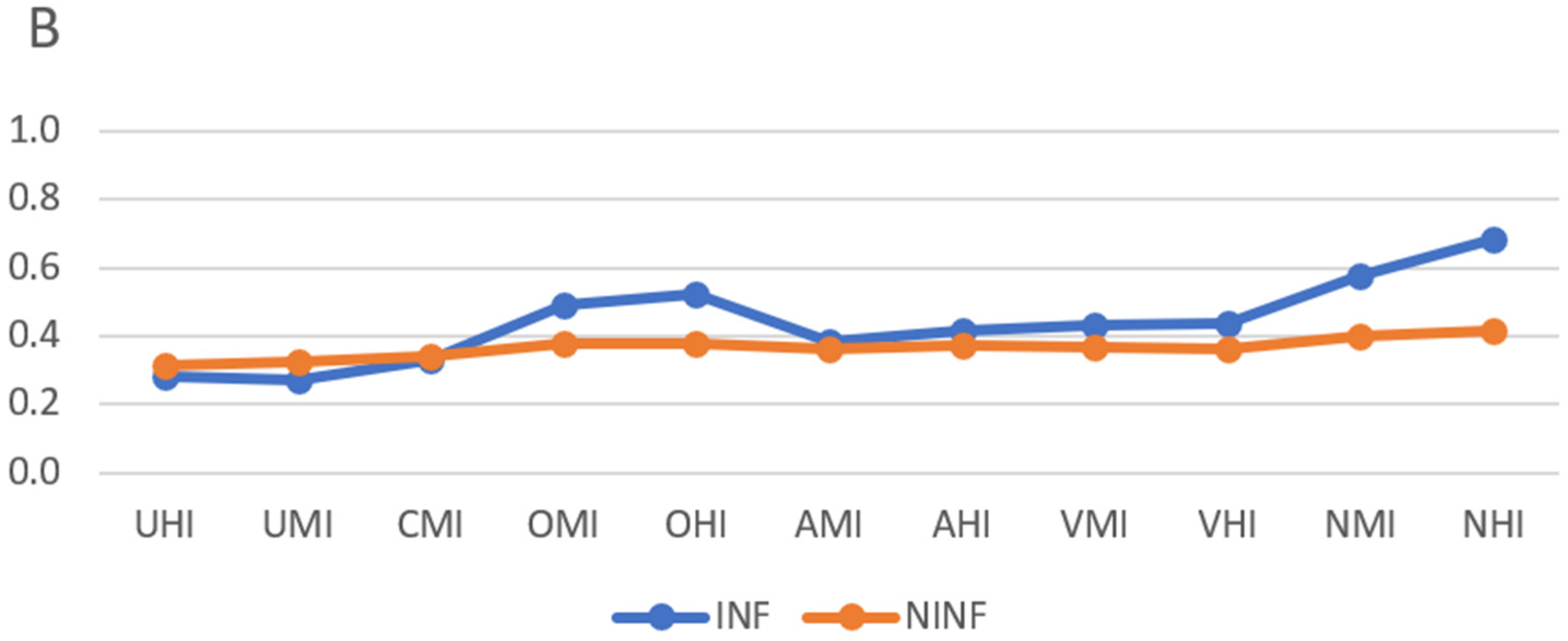
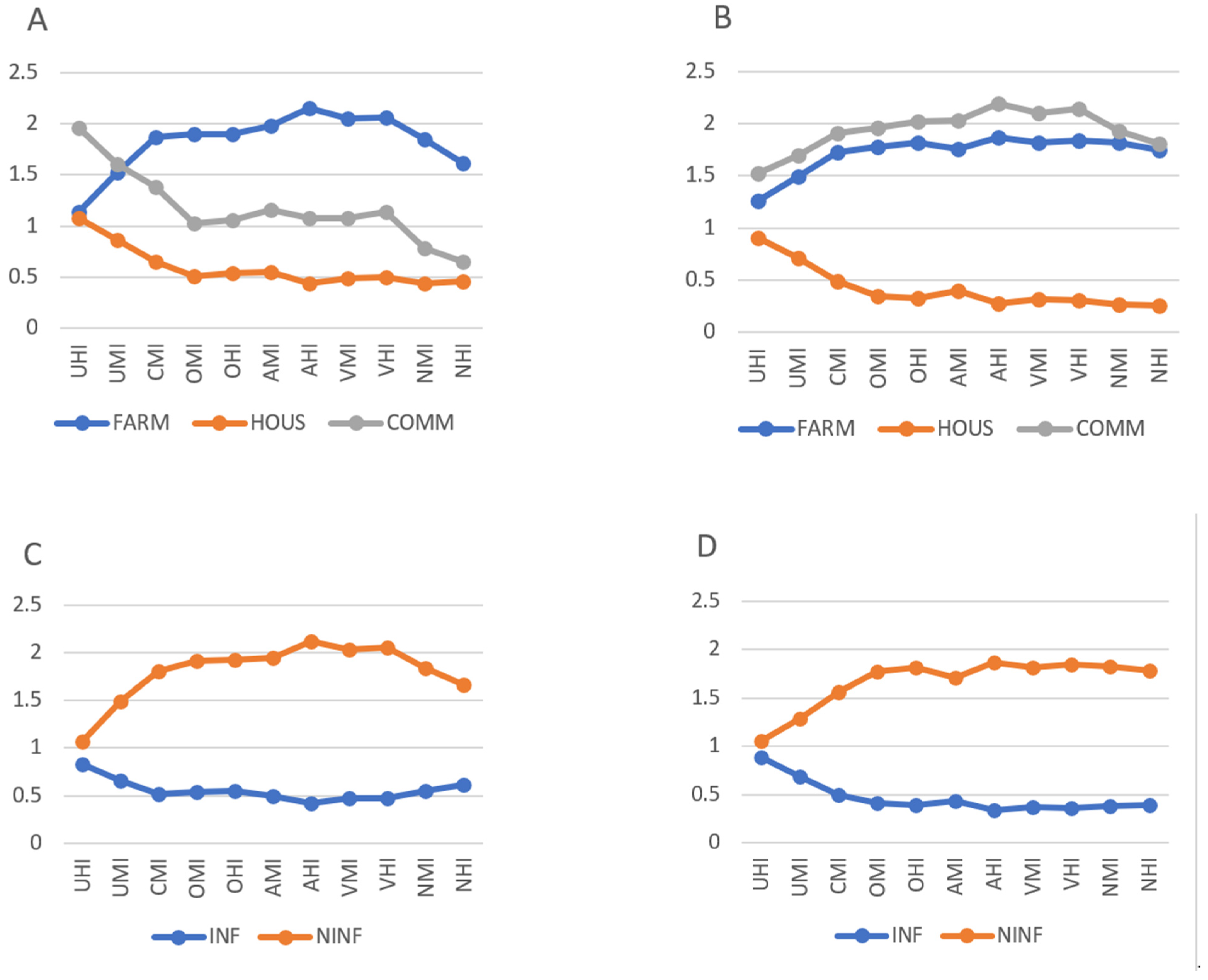

| Landscape Code | Landscape Name | Description |
|---|---|---|
| UHI | Urban high intensity | Landscape highly dominated by the urban component |
| UMI | Urban medium intensity | Landscape dominated by the urban component, with sparse natural, agricultural, and commercial elements |
| CMI | Commercial medium intensity | Landscape dominated by commercial buildings, with high presence of roads, mixed with sparse natural, agricultural, and urban elements |
| OMI | Olive yards medium intensity | Landscape dominated by olive yards, with relatively widespread residential settlements, sparse arable lands, and natural linear elements |
| OHI | Olive yards high intensity | Landscape highly dominated by olive yards |
| AMI | Agricultural medium intensity | Landscape dominated by arable lands, with relatively widespread urban features and sparse natural elements, vineyards, and rare olive yards |
| AHI | Agricultural high intensity | Landscape highly dominates by arable lands |
| VMI | Vineyards medium intensity | Landscape dominated by vineyards, with sparse arable lands, natural elements, and small urban settlements |
| VHI | Vineyards high intensity | Landscape highly dominated by vineyards |
| NMI | Natural medium intensity | Landscape dominated by woods and linear wooded features frequently framing agricultural lands, olive yards, and isolated buildings |
| NHI | Natural high intensity | Landscapes highly dominated by woods and wooded features |
| Perspective | Scenario Code | Purpose | Services with Higher Importance | Relevant References |
|---|---|---|---|---|
| Baseline | BASE | Obtain a reference suitability index for comparison of scenarios | Same importance to all the services | |
| Economic activities | FARM | Identify the most suitable area for farming activity | Services for farming activity | [25,57] |
| HOUS | Identify the most suitable area for housing | Services for housing | [25,36,58] | |
| COMM | Identify the most suitable areas for commercial and production activity | Services for industrial and commercial activity | ||
| Infrastructural needs | INF | Identify areas with high demand of infrastructures | Services with accessibility needed | [13,32,35,59] |
| NINF | Identify areas that deliver unmovable services | Services with accessibility not needed |
| Indicator Type | Indicator Subtype | Potential Demand-Min | Potential Demand-Max |
|---|---|---|---|
| Presence–absence | Density of point features | Absence | One point per cell (250 m2) |
| Presence–absence | Areal features | Absence | Presence |
| Intensity | Indicators for which demand is supposed to be = max of the indicator in all the study area | Absence | Theoretical maximum of the indicator |
| Intensity | Indicators for which potential demand vary across space due to landscape features variation (slope, LULC, sub-basins) | 0% of the (potential or real) demand is satisfied by the service | 100% of the (potential or real) demand is satisfied by the service |
Publisher’s Note: MDPI stays neutral with regard to jurisdictional claims in published maps and institutional affiliations. |
© 2021 by the authors. Licensee MDPI, Basel, Switzerland. This article is an open access article distributed under the terms and conditions of the Creative Commons Attribution (CC BY) license (https://creativecommons.org/licenses/by/4.0/).
Share and Cite
Antognelli, S.; Vizzari, M. Assessing Ecosystem and Urban Services for Landscape Suitability Mapping. Appl. Sci. 2021, 11, 8232. https://doi.org/10.3390/app11178232
Antognelli S, Vizzari M. Assessing Ecosystem and Urban Services for Landscape Suitability Mapping. Applied Sciences. 2021; 11(17):8232. https://doi.org/10.3390/app11178232
Chicago/Turabian StyleAntognelli, Sara, and Marco Vizzari. 2021. "Assessing Ecosystem and Urban Services for Landscape Suitability Mapping" Applied Sciences 11, no. 17: 8232. https://doi.org/10.3390/app11178232
APA StyleAntognelli, S., & Vizzari, M. (2021). Assessing Ecosystem and Urban Services for Landscape Suitability Mapping. Applied Sciences, 11(17), 8232. https://doi.org/10.3390/app11178232







